Pear Insect Pests
Pear Insect Pests
San Jose scale
Biology- Nymph: Female San Jose scales lay eggs which immediately hatch to colourless that emerge from under the edge of the scale covering. Each female lay birth to 200-400 eggs. These tiny yellow crawlers wander in a random fashion until they find a suitable place to settle. Immediately upon settling, the crawlers insert their mouthparts into the host plant and begin feeding and secreting a white waxy material (white cap stage); eventually the waxy covering turns black and is known as the black cap stage. Later the covers turn various shades from gray to black.
- Adult: Immature male and female scales are indistinguishable until the first molt. At this time, the male scale covering begins to elongate, while the females remain circular. Males molt a total of four times. Following the final molt, adult male scales emerge from the scale covering as tiny, yellow winged insects. They mate with the females who remain under the scale covering. Female insect body covered with grey scales. Yellow lemon coloured female is visible when covering is lifted. Female scales are very prolific and over a 6-week period can produce approximately 400 young. Crawlers move around for a short period in search of a suitable place to settle. It takes 25 days for males to mature and 31 days for females Five to six generations in a year.
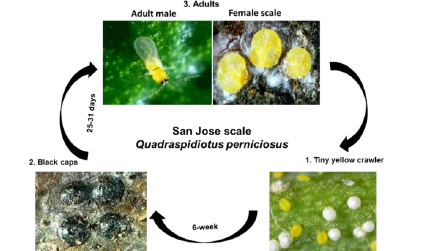
- Nymph and female scales attack all above ground parts.
- Feeding site turns into a characteristic purplish red colour.
- Initially growth of plant is checked but as scale increases in number plant may die.
- Fruits will have distinct “measles” spots on the surface.
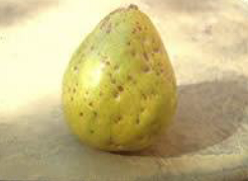
- Parasitoids: Encarsiaperniciosiand Aphytisdiaspidis(proclia group) etc
- Predators: Coccinellid (Chilocorus infernalis, Pharoscymnus flexibilis) etc.
Pear psylla
Biology- Egg: Eggs are minute, oval, and creamy white to yellow. Eggs laid before buds open in spring, and through early fall, eggs are deposited in lines or rows on the terminals and fruit spurs after buds open, eggs are deposited along mid-veins and petioles of developing leaves and on stems and sepals of blossoms. Eggs hatch when foliage appears and continue throughout growing season.
- Nymph: Early instars are about 1.6 mm long and light yellow; later instars are dark green to dark brown with wing pads and two conspicuous red eyes. Nymphs are cylindrical, but appear flattened and found on the undersides of leaves. Pass through five instars, which are generally covered by a drop of honeydew.Moves little at first but later instars move easily. Feeds and develops on new growth and water sprouts. Produces honeydew.
- Adult: Adults are 4 mm long and red-brown to black; larger and darker than summer adults. It resembles miniature cicada with wings held roof-like over the abdomen. Hides under bark, under litter on the orchard floor, or in sites outside the orchard. Adults leave the pear trees in Oct.-Nov. for wintering sites and return about 6 weeks before bloom. Feed by sucking juice from the host tree. Begin laying eggs after buds begin to swell.
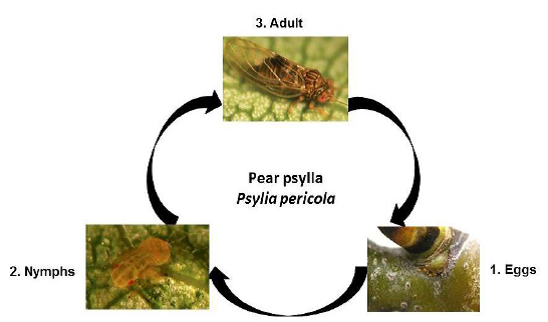
- Nymphs and adults suck sap primarily from the tender foliage of the new shoots and water sprouts. Feeding by nymphs produces a large amount of honeydew, which makes the tree sticky and promotes the growth of sooty mold (black fungus). The honeydew can run onto fruit causing dark russet blotches or streaks resulting in unmarketable fruit.
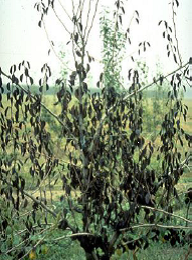
Natural enemies of Pear psylla
Predators:Lacewings, ladybird beetle, minute pirated bugs, predatory mites, anthocorid bugs, Spiders etc.
Green peach aphid
Biology- Egg: Eggs are deposited on Prunus spp. trees. The eggs measure about 0.6 mm long and 0.3 37 mm wide, and are elliptical in shape. Eggs initially are yellow or green, but soon turn black. Mortality in the egg stage sometimes is quite high.
- Nymph: Nymphs initially are greenish, but soon turn yellowish, greatly resembling viviparous (parthenogenetic, nymph-producing) adults. There are four instars, with the duration of each averaging 2.0, 2.1, 2.3, and 2.0 days, respectively. Females gave birth to offspring six to 17 days after birth, with an average age of 10.8 days at first birth. The average length of life is about 23 days, but this was under caged conditions where predators were excluded. The daily rate of reproduction averaged 1.6 nymphs per female. The maximum number of generations observed annually during these studies was determined to be 20 to 21, depending on the year.
- Adult: Up to 8 generations may occur on Prunus in the spring, but as aphid densities increase winged forms are produced, which then disperse to summer hosts. Winged (alate) aphids have a black head and thorax, and a yellowish green abdomen with a large dark patch dorsally. They measure 1.8 to 2.1 mm in length. Winged green peach aphids seemingly attempt to colonize nearly all plants available. They often deposit a few young ones and then again take flight. This highly dispersive nature contributes significantly to their effectiveness as vectors of plant viruses.
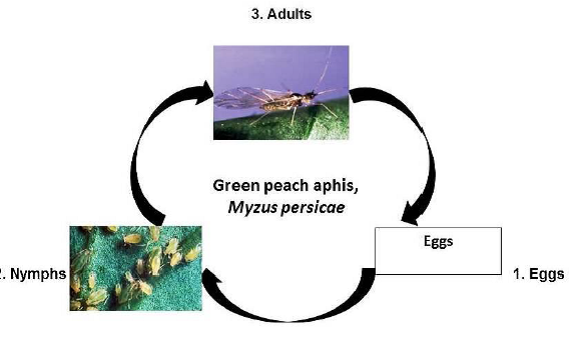
- G
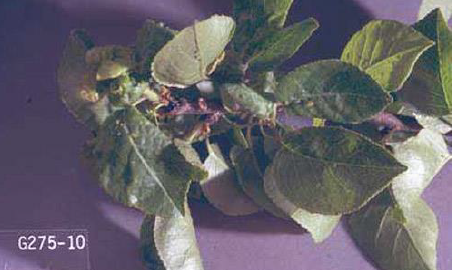 reen peach aphids can attain very high densities on young plant tissue, causing water stress, wilting, and reduced growth rate of the plant.
reen peach aphids can attain very high densities on young plant tissue, causing water stress, wilting, and reduced growth rate of the plant. - Prolonged aphid infestation can cause appreciable reduction in yield of root crops and foliage crops. Early season infestation is particularly damaging to potato, even if the aphids are subsequently removed.
- Contamination of harvestable plant material with aphids, or with aphid honeydew, also 38 causes loss. Blemishes to the plant tissue, usually in the form of yellow spots, may result from aphid feeding.
- Parasitoid: Aphelinus sp
- Predators:Syrphid fly, lygaeid bug, Coccinellid, Lacewing
Stem borer
Biology- Egg: Female lays egg inside cavity on a shoot. Eggs are very difficult to see and are laid singly on the trunk of the tree.
- Larva: Larvae of all three species are dirty white with a reddish-brown
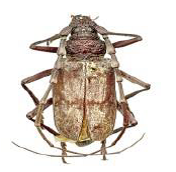 head and thoracic shield (area behind the head). Grub emerges in 7-8 days and start feeding by boring inside the stem. Grub longevity 2 years. Grub remains quiescent during winter and resumes feeding in March.
head and thoracic shield (area behind the head). Grub emerges in 7-8 days and start feeding by boring inside the stem. Grub longevity 2 years. Grub remains quiescent during winter and resumes feeding in March. - Pupa: Pupae are small, yellow-brown and sometimes observed as pupal cases partially protruding from the adult exit holes in the trunk or infested burr knots. Pupation takes place inside a tunnel made in the woody tissue.
- Adult: Adult beetles 35-50 mm long and grey in colour having long antennae.
- Caused by grub and adult, grub more destructive.
- Grub makes a tunnel and reaches close to trunk of tree.
- Vitality and productivity of plant is greatly impaired.
Root borer
Infests fruit and forest trees. Pear is the most preferred host. Adults attracted to light
Biology- Egg: Female lays eggs singly or in small clusters in soil. Eggs are 1.3 mm in size. Newly laid eggs are white with a tinge of yellow and become dark brown before hatching.
- Grub: Grubs feed on the root. Grub longevity 3.5 years. Grubs are cruciform, yellowish-white in colour. Development period ranges between 3-4 years. The full feed grub reach 80 mm length and 12 mm in width.
- Pupa: The pupae are about 48 mm long and usually found about 20–30 cm deep in the soil. Pupation in earthen cell inside soil.
- Adult: The adult beetle is chestnut red in color and bears long serrated antennae.
Life cycle
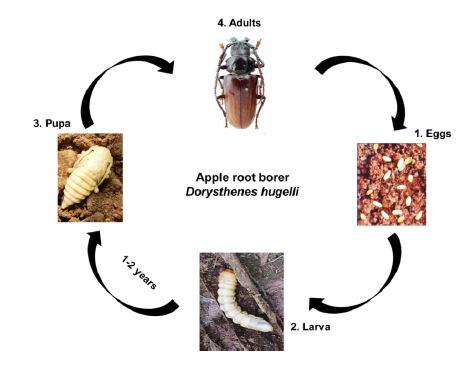
- Grubs either bore or girdle around the roots.
- The leaves become small and the branches wither.
- Tree becomes shaky and may die.
Codling moth
The rate of development will vary with temperature, proceeding more rapidly in warmer weather and climates. Depending on the climate, codling moth can have two, three, and sometimes four generations per year.
Biology- Egg: Eggs are deposited singly on pears and leaves. Each egg is about the size of a pin head and is translucent, gradually darkening as the egg nears hatching (Figure 6). Eggs hatch in six to 14 days, depending on temperature. Within 24 hours of hatching the larvae burrow into the fruit. The first instar larvae have a pink body with a black head and are approximately 1/10 inch in length. The number of eggs laid per female ranges from 30 to 70.
- Larva: After the eggs hatch, young larvae seek out and bore into fruit or developing nuts. Codling moth overwinters as full-grown larvae within thick, silken cocoons under loose scales of bark and in soil or debris around the base of the tree. Larvae appears to be cannibalistics. Full grown larva pinkish or creamy white with brown head and pupates in the soil litter.
- Pupa: After completing development they leave the fruit and drop from the trees to search out pupation sites and continue the life cycle in the soil or on debris under the tree; some crawl back up the tree to pupate in bark crevices. The larvae pupate inside their cocoons in early spring and emerge as adult moths mid-March to early April. The moths are active only a few hours before and after sunset, and they mate when sunset temperatures exceed 62°F.
- Adult: Adults are about 1/2 to 3/4 inch long with mottled gray wings that they hold tentlike over their bodies. Their appearance blends well with most tree bark, making them difficult to detect. If you are trapping the adults, you can distinguish codling moth from other moths by the dark, coppery brown band at the tip of their wings. Adult forewings are dark grayish with waxy lines with a copper colored eye like circle toward margin.
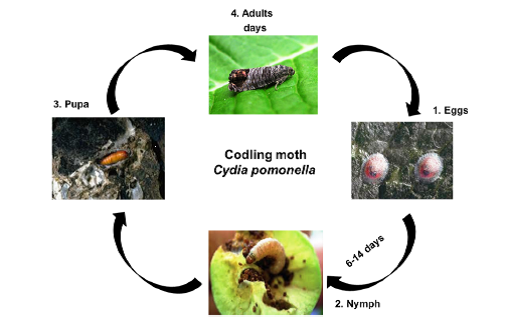
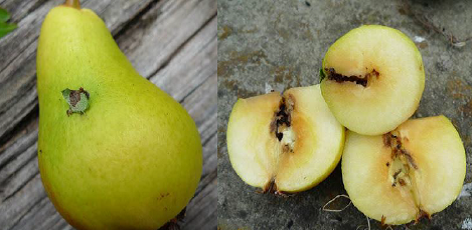
- It is a direct pest and hence causes severe damage to the fruit
- Neonate larva enters the fruit through calyx and feeds on seed.
- Infested fruits lose their shape and fall prematurely.
- 30 to 70 per cent pear fruits are rendered unmarketable
- Parasitoids:Trichogramma embryophagum, T. cacoeciaepallidum etc.
- Predators:Birds (grey tit, Parus major and Passer domesticus)
Thrips
Biology- Egg: The eggs are deposited within plant tissues singly.
- Nymph andpupa: Larvae have two stages, which feed on plant tissues. The second instar larvae, when mature, fall to ground, where they molt to prepupae and pupae in the soil.
- Adult: After emergence, the adults move to the growing parts of the plants such as young leaves, flowers, or young fruits, where they feed and lay eggs (about 200 eggs per female). Adults are usually found on young leaves, while larvae are found on lower or older leaves. At 25°C, the life cycle is completed in approximately 17 days. Adults are winged sucking rasping insects ranging from 5-14 mm in length. Their slender bodies are shiny pale or black with silver stripes.
Life cycle completed in 11-43 days. Produce many generations in a year heaviest damage occure in spring. In colder region, life cycle is longer with fewer generations.
Life cycle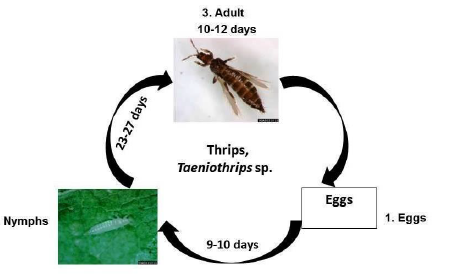
Damage
- Most species of plant feeding thrips, have rasping and sucking mouthparts.
- The surface of the leaf develops a crinkled silvery appearance as a result of damage to cells below the surface.
- Lightly-infested plants show silvery feeding scars on the under surface of leaves, especially alongside the mid rib and veins.
- Heavily-infested plants show silvering and browning of leaves, stunting of young leaves and terminal growth, with fruit scarred and deformed.
- Developing leaves become distorced in the growing tips.
Predators: Antlion, predatory thrips, coccinellids, anthocorids, lygaeids etc.
Mites
Biology- Egg: Overwintering eggs are deposited in groups on roughened bark areas, especially around the base of buds and fruit spurs. Egg hatch is closely correlated with bud development and first occurs when buds are in the tight cluster stage; hatch is better than 50% complete at the pink stage, and virtually 100% complete by the end of bloom. The first summer eggs as a rule can be found at petal fall or at latest by fruit set. The summer eggs are globular and somewhat flattened (onion shaped) . They are bright red to dark orange, and average 0.13 mm in diameter. The overwintering egg is deeper red and slightly larger, averaging 0.14 mm. The egg surface is ridged with the grooves running toward the top center from which a slender tapering stalk (0.1 mm) arises. The average incubation period of the summer eggs for each generation varies from 6.7 to 14.4 days, the shortest period being in mid-summer.
- Nymph: Nymphs consist of larva, protonymph and deutonymph. A quiescent or resting period precedes each molt to the following stage. The hatching larva is about 0.2 mm in length, light orange in color and 6 legged. All subsequent stages have 8 legs. With the exceptions of an increase in size and the ability to differentiate sexes in the deutonymphal stage, there are no conspicuous changes in structure or color between the nymphal instars. The average 43 developmental time from eclosion to adulthood ranges from 5.5-15 days, depending on the generation.
- Adult: The sexes of the adults are readily differentiated. The female has a globular bodywhich ranges in length from 0.38 to 0.40 mm, is velvety brown to brick red, and has 4 rows of dorsal setae or spines borne on raised white tubercles. The body color and setal pattern distinguish this species from all other plant feeding mites. The male is smaller, 0.26-0.28 mm in length, lighter in color and has a pointed abdomen and proportionately longer legs.Reproduction can be both sexual and parthenogenetic. Unfertilized eggs give rise to males only, while mated females produce both sexes.The average preoviposition period of females is about 2 1/2 days. Although some females in insectary studies have lived 39 days, the average life span is 18 days. The oviposition period averages 12.5 days with 18.8 eggs produced per female.
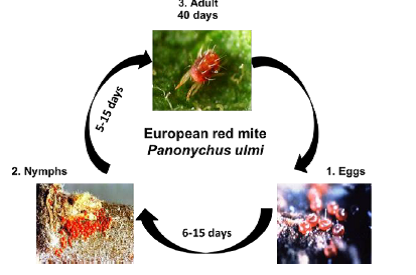
- European red mite feeds on leaves.
- Severe mite injury produces browning and loss of colour in the leaves i.e. bronzing.
Predators: Coccinellid, Lacewing, Predatory mite, predatory thrips, spider etc.
IPM for Pear
To know the IPM practices for Pear, click here.
Source: NIPHM; Directorate of Plant Protection, Quarantine & Storage
Last Modified : 4/2/2020
This topic covers information about Walnut Insect...
This topic provides information about Apricot- In...
This topic covers information about Description of...
This topic provides information about Cherry- Inse...
